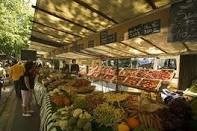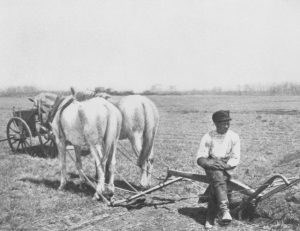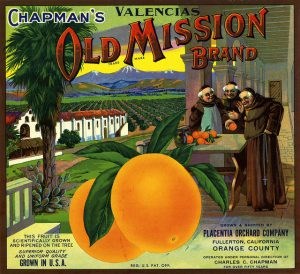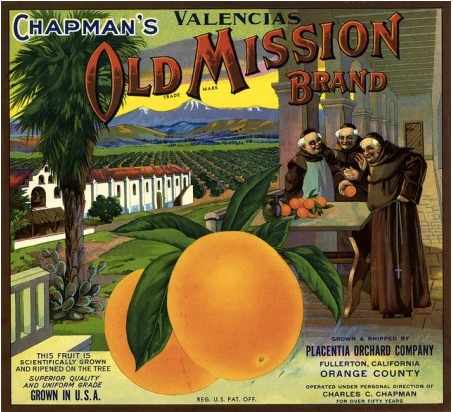"The Art of Seeing" by Michael Milton
I often hurry past those fruit and vegetable stands set up outside corner grocery stores, the kinds one sees all over Brooklyn. But unless I'm looking for something to take home for dinner, the stand is most often a blur of colors and shapes as I race by.

Recently, though, something caught my eye and I stopped to take a closer look and experienced a lovely wave of nostalgia. I was looking at a pre-painted cardboard shipping box, filled to the brim with peaches from Frahlinger's Farms out in New Jersey. The box featured a picture of a fanciful sun shining brightly down from an impossibly blue sky, casting rays on a verdant peach orchard.
The shipping crate label for a cherry orchard near where I was raised in San Jose, CaliforniaShipping crate art takes me back to my own farm heritage. I was raised in the Santa Clara Valley in California, before 'Silicon Valley' was a gleam in the eyes of the likes of Jobs, Gates and Ellison. Santa Clara—like the farms of 19th century Brooklyn-- was blessed with incredibly fertile soil.

And as with Santa Clara, Brooklyn's agricultural history now lies under brick, black top, concrete and steel. Back in the day, the crops from the farms of Brooklyn mainly went directly to feed the hungry maws of nearby Manhattan, so fancy packing was not required. However, the cornucopia of produce which came from California was mostly shipped further away-- not only across our state—but across the country.

And before the pre-painted cardboard shipping boxes there were small lathe built crates with pasted on, highly stylized lithographic paper labels which identified each farm where the produce had been grown. Those crates with their labels were the farms' calling cards, advertising what they grew far out in the world.
The West Coast's crate art was a tribute to California's enormous fecundity made greater by its geographic encapsulation of several growing zones where most anything could be grown. Crate art was rich with images of fruits and orchards, red tiled roofed haciendas and happy señoritas, all evoking sunny California.

Santa Clara Valley (now 'Silicon Valley') circa 1900, an agricultural hub in CaliforniaBlossom Farm Cherries, for instance, were near our home in San Jose and had their name on their logo in a beautiful red script, the letters intersected by a branch covered in cherry blossoms on one side with red, ripe cherries on the other. The label for Chapman's Valencia Old Mission Brand featured snowcapped mountains and a California mission surrounded by orange groves and in the foreground, a trio of padres clearly pleased with what they are producing there.

When I left home back in the late 1970s, I had opportunities to travel in Europe. In France and Germany I had my first introduction to the outside fruit market; simple displays of produce that could have (and probably HAD) just come in from the fields outside the town, often with several tall thin metal canisters featuring locally grown seasonal flowers. These street side vendors romanced my imagination back hundreds of years to the open air markets which were a part of every square of every medieval town and city across the continent. I was thrilled to see similar vendors when I moved to Brooklyn.
In this country, big scale farming did away with the need for individual farms to identify themselves by way of their crate art. Still, around the Holidays, take a look around your 'hood; you will see the small and surprisingly sturdy wooden boxes of my youth filled with clementines or 'Christmas oranges' with their grower's logo pasted to the side.
I can rarely resist buying one.




